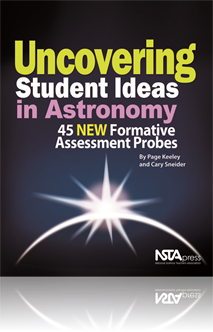All Earth & Space Science resources
NSTA Press Book
Teaching Science Through Trade Books
“‘What was your favorite book as a child?’ In more than 10 years of facilitating workshops, we have never heard anyone reply, ‘My fourth-grade science textbook.’ Clearly, textbooks have an important place in the science classroom, but usin...
By Christine Anne Royce, Emily Morgan, Karen Ansberry
Book Chapter
The purpose of this assessment probe is to elicit students’ understanding of the Earth- Sun-Moon system well enough to explain the causes of Moon phases and solar eclipses and how these two phenomena are related. ...
Book Chapter
The purpose of this assessment probe is to elicit students’ ideas about how astronomers investigate the composition of stars. The probe is designed to see if students recognize that the colors from the light given off by a star (its spectrum) revea...
Book Chapter
The purpose of this assessment probe is to elicit students’ ideas about relative distance. The probe is designed to find out if students can apply the same scale used to represent the difference in sizes between the Earth and Sun to also repre...
Book Chapter
The purpose of this assessment probe is to elicit students’ ideas about eclipse phenomena. The probe is designed to determine if students have a mental model of the Earth-Sun-Moon system that allows them to figure out why we see more eclipses of th...
Book Chapter
How Long Is a Day on the Moon?
The purpose of this assessment probe is to elicit students’ ideas about the day-night cycle on the Moon. The probe is designed to find out if students can coordinate two concepts: the Moon turns once on its axis each month, and half of the Moon ...
Book Chapter
The purpose of this assessment probe is to elicit students’ ideas about Earth’s gravity. The probe is designed to find out how students think gravity acts inside the Earth. ...
NSTA Press Book
Uncovering Student Ideas in Astronomy: 45 New Formative Assessment Probes
What do your students know—or think they know—about what causes night and day, why days are shorter in winter, and how to tell a planet from a star? Find out with this book on astronomy, the latest in NSTA’s popular Uncovering Student Ideas in ...
By Page Keeley, Cary Sneider
Book Chapter
Using a model, learners explore time zones and what causes day and night and how time zones change. Learners observed the position of the Sun in the sky at different times of day and relate those positions to the rotation of the Earth. For more info...
NSTA Press Book
Hard-to-Teach Science Concepts: A Framework to Support Learners, Grades 3–5
Authors Susan Koba and Carol Mitchell introduce teachers of grades 3–5 to their conceptual framework for successful instruction of hard-to-teach science concepts. Their methodology comprises four steps: (1) engage students about their preconception...
By Susan B. Koba with Carol T. Mitchell



